|
|
|
|
|
BAKU 獏 or 貘
Eater of Nightmares
Origin = China & Japan
The elephant-like Baku 獏 (also written 貘) is an imaginary and composite creature from Chinese mythology thought to prevent or devour nightmares. It has the trunk and tusks of an elephant, the eyes of a rhinoceros, the tail of a cow, and the paws of a tiger. <source: early 17th-century Japanese text Sankai Ibutsu 山海異物> It is the eater of bad dreams, and helps to ensure that one’s first dream (Hatsu Yume 初夢) during the New-Year holiday is favorable and auspicious.
Images of Baku are frequently placed under the eaves of Japanese temples and shrines to ward off evil spirits, as are images of the magical shishi (lion) and the dragon. All three commonly serve as decorative and protective architectural elements at Buddhist temples and Shintō shrines. Baku effigies rose to popularity in the Edo period (1603 to 1868). The character for Baku (獏 or 貘) is also the Japanese name for a real-life mammal known as the tapir (an animal shaped like a pig but with a long snout).
Baku images and talismans are also frequently placed under one’s pillow to ward off bad dreams and ill omens. The kanji for Baku, for example, is occasionally written on the sail or hull of the Treasure Boat of Japan’s Seven Lucky Gods. Children are told to place a picture of this boat (or of Baku) under their pillows on the evening between Jan. 1 and Jan. 2. Local custom says if they have a good dream that night, they will be lucky for the whole year, and the chances of having a good dream are reportedly enhanced by calling upon Baku (details here).
Indeed, pictures of Baku, Baku-shaped pillows, pillowcases with Baku's kanji (獏) written on them, Baku toys, and other Baku talismans are still readily available in Japan. Today the Baku commonly appear in Japanese cartoons, computer games, and comic books.
|
|
|
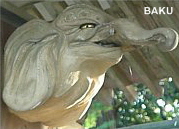
Ryūtakuji Temple 龍沢寺, Shizuoka
Photo by A-to-Z Dictionary
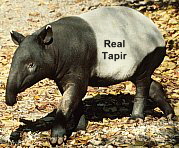
Photo this E-Site
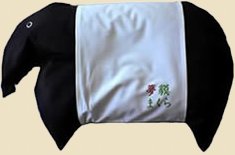
Baku Makura 獏枕 (Baku Pillow)
Modern pillow of Baku, used to ward
off evil dreams & devour nightmares.
Photo this J-site.
|
|
|
|
|
|
|
|
|
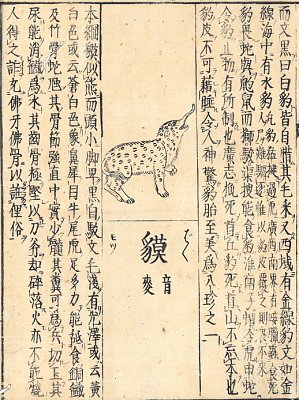
|
|
PHOTO: Baku in the Kinmōzui 訓蒙図彙 or 訓蒙圖彙 (Collected Illustrations to Instruct the Unenlightened), a 20-volume Japanese work compiled in 1666 by Nakamura Tekisai 中村惕斎 (1629-1702) and considered Japan's first illustrated encyclopedia. The above image, however, comes from a sequel published in 1789 called 頭書増補訓蒙圖彙大成. See digitized version at Kyūshū Univ. Museum Digital Archive.
|
PHOTO: Baku in the Wakan Sansai-zue 和漢三才図会 (Illustrated Sino-Japanese Compendium of Heaven, Earth, and Humanity), a 105-volume Japanese encyclopedia completed around 1712 - 1715 AD, attributed to Terajima Ryōan 寺島良安. See digitized version at Kyūshū University Museum Digital Archive.
|
|
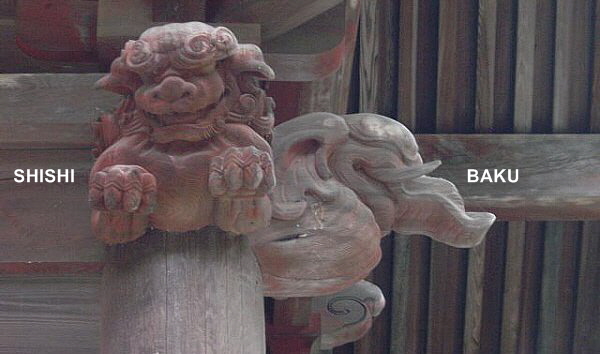
Shishi 獅子 and Baku 獏 adorn many temple & shrine structures in Japan.
Photo taken at Myōhonji Temple 妙本寺, Kamakura. Photo by A to Z Dictionary.


|
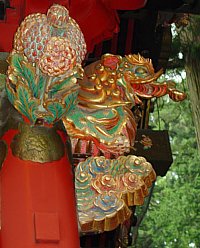
Nikkō Tōshōgū Omotemon
日光東照宮表門 (Tochigi)
Photo courtesy JAANUS
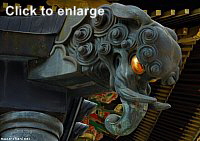
Baku at the Bell Tower,
Nikkō Tōshōgū Shrine 日光東照宮
in Tochigi. Photo = this J-Site
|
|
 ABOUT BAKU ABOUT BAKU
Says the early 17th-century Japanese illustrated document Sankai Ibutsu 山海異物 (Mythical Creatures of the Mountains and Seas): “In the mountains of the south, there lives a beast. It has an elephant's trunk, the eyes of a rhinoceros, an ox's tail, and a tiger's paws. Its body is yellow and black, and is called the Mò 貘 [in China]. By sleeping on its pelt one can ward off pestilence. A man should make a sketch of the Mò in order to be protected from evil. It eats copper and iron but nothing else.” <end quote> Learn more about this illustrated Japanese book.
Says scholar Louis Frédéric in his Japan Encyclopedia (Harvard University Press): “Mythical animal of Chinese origin, vaguely resembling a tapir, supposed to be able to swallow anything, even mountains. It also swallows children's nightmares.” <end quote>
Says JAANUS: "Bakuhana 獏鼻. Literally tapir nose. Also called Bakugashira 獏頭. A type of nosing (kibana 木鼻), based on a tapir's pointed nose. Over time it became a stylized amalgamation of the tapir and the face, nose and tusks of an elephant. From a frontal view it sometimes looks like a human face. It was popular in Japan from the 17th - 19th centuries. One example is found on the 17th-century Front Gate, Omotemon, at Nikkō Tōshōgū 日光東照宮 in Tochigi prefecture.” <end JAANUS quote>
Says reader Ken Prescott: “The elephant-like animal often associated with shishi, and used like the shishi as architectural decorations (kibana 木鼻 or decorated beam-ends), are the baku, known as eaters of nightmares in Japanese mythology. They are a composite animal and are very often depicted in Japanese netsuke. In fact, probably the best English-language references and examples are to be found in books on netsuke. I have also seen drawings from the Kano school (or influenced by same) with both baku and shishi, and know of one ukiyoe (woodblock) print showing a baku on a bed cover (appropriately). The Tokugawa shrine at Nikkō is loaded with dragons, shishi, and baku.” <end quote>
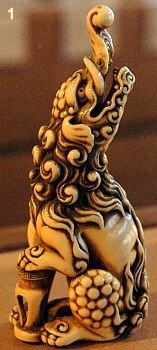 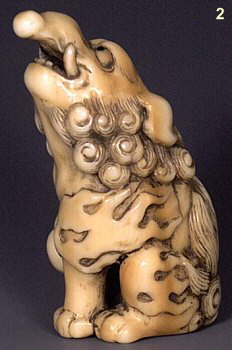
- Baku Netsuke, Raymond & Frances Bushell Collection, Los Angeles County Museum of Art.
Netsuke Room of the Japanese Pavilion. Photograph by Marshall Astor.
- Baku Netsuke, Standing, Ivory, Unsigned, 18th century. Photo from Bosshard.net.

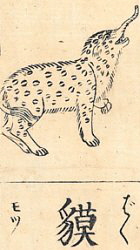  BAKU, DREAMS, & FIRST DREAM OF NEW YEAR BAKU, DREAMS, & FIRST DREAM OF NEW YEAR
Sometime in Japan’s Edo period (1603 to 1868), pictures of Baku, or ideograms of the Chinese character for Baku (獏), or drawings of the Treasure Boat of Japan’s Seven Lucky Gods with the kanji for Baku written on the sail (see below photos), were placed under one’s pillow to provide protection against bad dreams. Pillowcases with a depiction of Baku were also widely sold.
These beliefs continue in modern times with Japanese traditions surrounding Hatsu Yume 初夢 (lit. “first dream” of the new year). Children are encouraged to stay up late and welcome in the New Year. On the evening between Jan. 1 and Jan. 2, children are likewise encouraged to place an image of the Treasure Boat of Japan’s Seven Lucky Gods under their pillow to ensure a good Hatsu Yume. The treasure boat (Takarabune 宝船) is laden with treasure (Takara 宝). Says JAANUS: “The Chinese character for BAKU 獏, a Chinese imaginary animal thought to devour nightmares, is sometimes found written on the sail. Often auspicious cranes and tortoises are depicted in the sky and the sea. Although the origin of treasure-boat paintings is not clear, one Edo-period record indicates they originated in the Muromachi period.” <end quote> If you have a lucky dream that night, you will be lucky for the whole year, but you must not tell anyone about your dream -- if you do, you forfeit its power. If you have a bad dream, you should call upon Baku -- “Oh Baku, devour my bad dream” -- or set your picture adrift in the river or sea to forestall bad luck. <Sources: JAANUS & Seven Lucky Gods of Japan by Chiba Reiko> by Chiba Reiko>
Says F. Hadland Davis in Myths and Legends of Japan (pp. 358-359): “When a Japanese peasant awakens from an evil nightmare, he cries ‘Devour, O Baku, devour my evil dream.’ At one time pictures of the Baku were hung up in Japanese houses and its name written upon pillows. It was believed that if the Baku could be induced to eat a horrible dream, the creature had the power to change it into good fortune.”
|
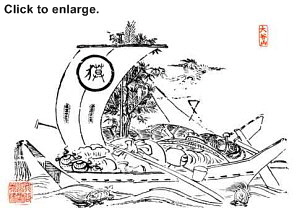
Treasure Boat. Baku written on sail. Modern.
From Gaya-in Temple 伽耶院, Miki City (Hyōgo)
Photo = This J-site.
|
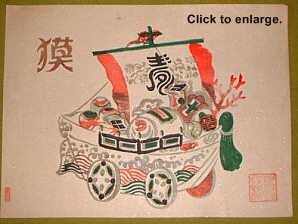
Baku written at left. 20th century, pre-WWII.
Treasure boat. Photo = This J-site.
|
|
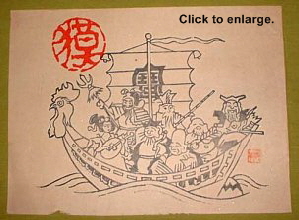
Baku written in red. 20th century, pre-WWII.
Treasure boat. Photo = This J-site.
|
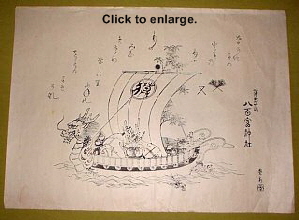
Baku written on mast of treasure boat.
20th Century, Pre-WWII. Photo = This J-site.
|
|
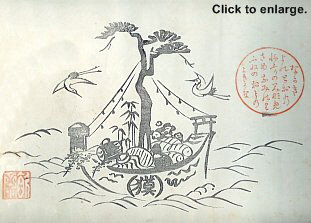
Treasure Boat. Baku written on hull. Late Edo period.
Drawing, with palindrome shown in red circle.
Photo = This J-Site
|
Another curious custom involving the treasure boat
is the chanting of a song-like palindrome (a verse that
reads the same backward or forward). Children are told
to chant the verse three times before going to sleep. In the
photo at left, the palindrome is shown in the red circle.
There are many variations of this palidrome 回文歌.
One widely known verse is:
長き夜のとをの眠りの皆目覚め
浪乗り船の音のよき哉
ながきよのとをのねぶりのみなめさめ
なみのりふねのをとのよきがな
Nagakiyonoto o noneburinominamesame
Naminoribuneno o tonoyokigana
Source. This J-Site.
|
|


BAKU 獏 - Eaters of Nightmares. Edo Period. Photo courtesy www.buddhist-statues.com
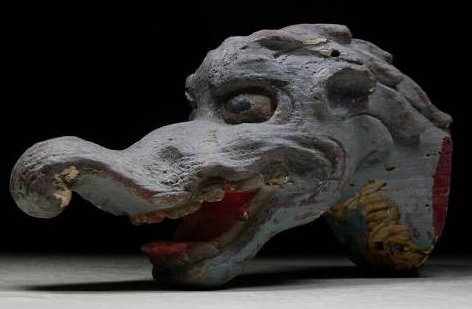
BAKU 獏 - Eater of Nightmares, Rare Carving. Said to bring good dreams. Piece in collection of James Miller.
|
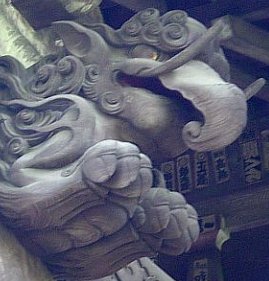
BAKU 獏 - Eater of Nightmares
Hōkaiji Temple 宝戒寺 (Kamakura)
Above two photos by A-to-Z Dictionary
|
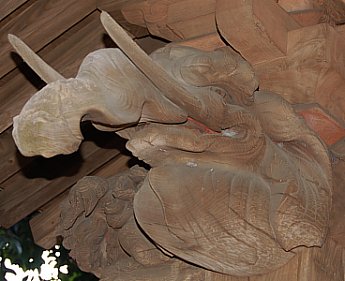
BAKU 獏 - Eater of Nightmares
Yagumo Jinja Shrine 八雲神社 (Tokiwa, Kamakura)
Dedicated to Susano Ō no Mikoto 須佐之男命, Hayatama no Ō no Mikoto 速玉之男命, and Izanami no Mikoto 伊弉冉命.
|
|
|
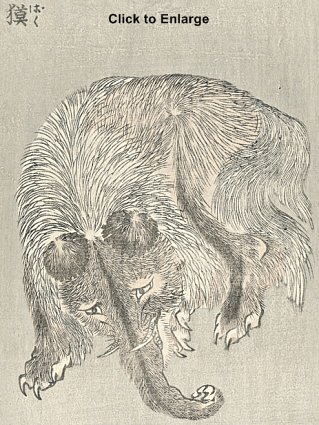
BAKU 獏 - Eater of Nightmares
by Katsushika Hokusai 葛飾北斎 (1760 to 1849)
Photo courtesy Evgeny Steiner (SOAS)
|
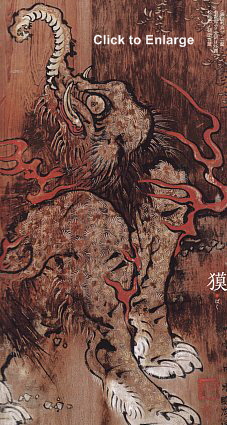
BAKU 獏 - Eater of Nightmares
Painting on Door (cedar), by Soga Shōhaku
曽我蕭白 (1730-1781). At Asada-ji Temple 朝田寺, Matsusaka City, Mie Pref. Photo this J-Site.
|
|
|
|
|
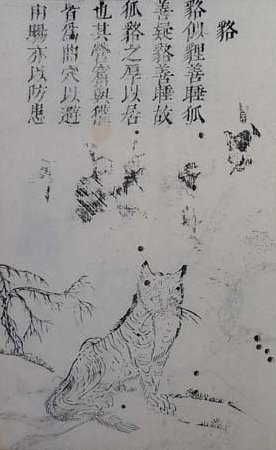
Mujina 貉 or 貉
Image from the San-ts'ai t'u-hui 三才圖會, a Chinese document dated to 1609 / 1610.
In Japan, the Mujina 貉 is considered equivalent to the Tanuki. But the above image looks strikingly
similar to a Baku, especially the long nose. Indeed, it looks very similar to the prior drawing by
Katsushika Hokusai. San-ts'ai t'u-hui 三才圖會 can also be romanized as Sāncái Tú Huì, or Sansai Zue.
Writes scholar Evgeny Steiner (SOAS): "Mujina is related to the Tanuki, and, as far as I know, has
no relationship to Baku. In Japan, Mujina was mentioned in the Nihon Shoki 日本書紀 (aka Nihongi or
Chronicles of Japan, released around 720 AD). Toriyama Sekien 鳥山石燕 (1712 – 1788) depicted him in his
Konjaku Gazuzoku Haykki 今昔画図続百鬼 (1779), and Katsushika Hokusai 葛飾北斎 (1760 to 1849) most
probably used Sekien's iconography (as well as that of the Sansai Zue)." <end quote> Photo courtesy this J-Site.
|
|

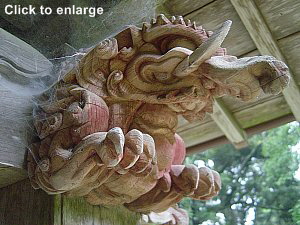
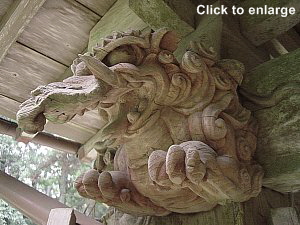
BAKU 獏 - Eaters of Nightmares
Mitake Jinja 御嶽神社 (also read Ontake Jinja) near Oami City, Chiba.
Photos by A-to-Z Dictionary
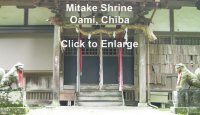 Mitake shrines are associated with the beliefs and practices of the Ontake mountain cult at Mt. Ontake in Kiso (Nagano Prefecture), with the deity Zaō Gongen, and with Japan’s Shugendō sects. The shrine here in Chiba is dedicated to Emperor Ankan 安閑天皇 (mid-6th century AD; 27th emperor of Japan) and also to Sukunahiko 少彦名命, a kami who assisted Ōnamuchi 大己貴神 (aka Ōkuninushi 大国主神, the land-forming kami) in the development of the land, and is thus considered an agricultural deity and tutelary of grains. Ōkuninushi is often identified with the Hindu-Buddhist deity Daikokuten 大黒天 (god of agriculture, commerce, and luck). Ōkuni 大国 can also be read "daikoku," which helps to explain the association with Daikokuten. During his reign, Emperor Ankan is credited with the construction of state granaries in large numbers throughout Japan. This small shrine in Chiba is located in a remote rural area devoted to rice growing. Mitake shrines are associated with the beliefs and practices of the Ontake mountain cult at Mt. Ontake in Kiso (Nagano Prefecture), with the deity Zaō Gongen, and with Japan’s Shugendō sects. The shrine here in Chiba is dedicated to Emperor Ankan 安閑天皇 (mid-6th century AD; 27th emperor of Japan) and also to Sukunahiko 少彦名命, a kami who assisted Ōnamuchi 大己貴神 (aka Ōkuninushi 大国主神, the land-forming kami) in the development of the land, and is thus considered an agricultural deity and tutelary of grains. Ōkuninushi is often identified with the Hindu-Buddhist deity Daikokuten 大黒天 (god of agriculture, commerce, and luck). Ōkuni 大国 can also be read "daikoku," which helps to explain the association with Daikokuten. During his reign, Emperor Ankan is credited with the construction of state granaries in large numbers throughout Japan. This small shrine in Chiba is located in a remote rural area devoted to rice growing.

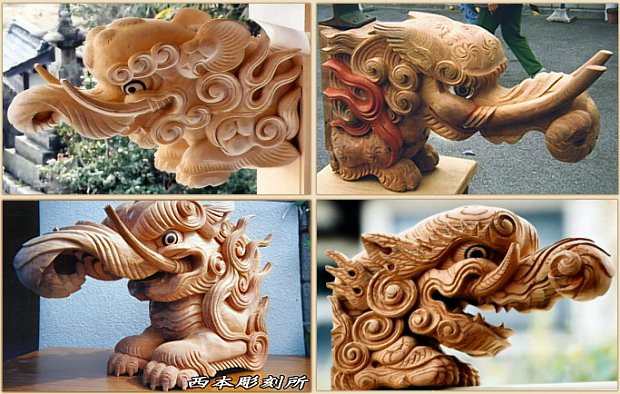
Modern Baku carvings from the Kazushi Nishimoto Workshop 西本彫刻所
Located in Matsuyama City 松山市, Ehime Prefecture. See their J-Site.

LEARN MORE
- Sankai Ibutsu 山海異物 (Mythical Creatures of the Mountains and Seas, two volumes). The Sankai Ibutsu is an early 17th-century illustrated Japanese book now in the Spencer Collection of the New York Public Library. See article by Masako Nakagawa (Villanova University) in Sino-Japanese Studies, Volume 11, pages 33-34, wherein she provides a description of Baku gleaned from the Sankai Ibutsu, from the Wang Ch'i 王圻, San-ts'ai t'u-hui 三才圖會 (dated 1609/10, 3 vols. Shanghai: Hsinhua shu-tien, 1988), and from John A. Goodall's Heaven and Earth: 120 Album Leaves from a Ming Encyclopedia: San-ts'ai t'u-hui, 1610 (London: Lund Humphries, 1979). View Nakagawa's article here (pages 33 and 34 describe Baku). Also see San-ts'ai t'u-hui at the Tokyo Metropolitan Library.
- For very early Japanese drawings and descriptions of Baku, see the Kinmōzui 訓蒙図彙 or 訓蒙圖彙 (Collected Illustrations to Instruct the Unenlightened), a 20-volume Japanese work compiled in 1666 by Nakamura Tekisai 中村惕斎 (1629-1702) and considered Japan's first illustrated encyclopedia. See digitized version at the Kyūshū University Museum Digital Archive. Also see the Wakan Sansai-zue 和漢三才図会 (Illustrated Sino-Japanese Compendium of Heaven, Earth, and Humanity), a 105-volume Japanese encyclopedia completed around 1712 - 1715 AD, attributed to Terajima Ryōan 寺島良安. See digitized version at Kyūshū University Museum Digital Archive.
- Early Buddhist Architecture in Japan, Japanese Arts Library, Vol. 9
by Kakichi Suzuki (Author), Mary Neighbor Parent (Translator)
- Japanese Architecture and Art Net Users System (JAANUS)
- Techniques used in carving Shishi and Baku decorations. See this J-site
- Hatsu Yume 初夢 (lit. “first dream” of the new year). See Gabi Greve’s worldkigodatabase.
- Myths and Legends of Japan, by F. Hadland Davis. Published by George G. Harrap & Company, London, 1913. See pages 358 and 359.
- 神仏信仰事典シリーズ (A Series of Books on Shin-Butsu Faith). By Miyada Noboru 宮田登, page 46. Published in 1998. View the Baku section of this book at Google Books.
- The Seven Lucky Gods of Japan
 , by Chiba Reiko. Charles E. Tuttle Co., 1966. , by Chiba Reiko. Charles E. Tuttle Co., 1966.
- SPECULATION. Baku may (or may not) be partly derived from a mythological Chinese creature known as Nián Shòu 年獸. This beast, said to live in the mountains, traditionally appeared during the Chinese New Year, and terrorized villagers by attacking their children. It was ultimately pacified by a sage, who instructed it to devour all evil, and then it disappeared. It is said to hate loud noises (like firecrackers) and abhors the color red, and thus, to this very day, the Chinese decorate there homes with red, wear red clothing, give out red envelopes, explode firecrackers, and perform lion dances during the New Year holiday to ensure the beast never returns.

ū ā ō Ō Ū
|
|